Take a tour of the BamBoo through the gallery above. All photos noted as courtesy of Patti Habib are copyright the Estate of Richard O’Brien and the BamBoo.
Article originally published July 16, 2013 by The Grid online (thegridto.com).
Denise Benson revisits the legendary restaurant and club that served as an island oasis amid a rapidly transforming Queen West strip.
BY: DENISE BENSON
Club: BamBoo, 312 Queen St. W.
Years in operation: 1983-2002
History: Like the best of clubs, Toronto’s BamBoo was produced out of friendships, late-night revelry, and the desire to create a unique experience for a core community. The path that co-owners Richard O’Brien and Patti Habib took to get there was filled with fateful turns.
Both were in media and loved the nightlife: O’Brien had been a freelance journalist and live-music booker in California before returning to Toronto where he worked for TVOntario and later CBC, while Habib was a story producer for CBC Radio’s As It Happens. In the late 1970s, O’Brien, also known to friends as Ricci Moderne, partnered with infamous bon vivant Marcus O’Hara to produce annual St. Patrick’s Day parties, dubbed the Martian Awareness Ball (2013 marked its 35th anniversary), with Habib joining them a few years in.
Not long after, the trio—along with a group of friends that also included Dan Aykroyd, publicist Joanne Smale, John Ball, and Roots co-founder Michael Budman—put together an extensive business proposal to re-open The Embassy Tavern, a 1960s Yorkville bar and live-music venue. The plans did not come to fruition. Instead, in 1980, O’Brien and Habib launched the MBC boozecan in what had been her third-floor loft at the corner of Liberty and Jefferson.
“I had to move out,” laughs Habib during a lengthy phone chat. “Richard brought in all his records, and it became an after-hours club opened Mondays—a theatre night—and Thursdays only.”
For two years, the duo drew crowds to this largely deserted part of town we now know as Liberty Village. They booked bands that ranged from reggae to Rough Trade, from a newly formed Parachute Club to soul man Junior Walker. Jamaican patties were the only food served. Income earned at the door was hidden in record covers, and put aside with larger goals in mind.
Habib and O’Brien were also regulars at influential upstairs Queen West boozecan-cum-nightly-artist-hangout The Paper Door. As luck would have it, on an evening spent sitting on the venue’s back balcony, O’Brien looked down and spotted Wicker World, a shop at 312 Queen St. W. set back from the street. The location had been a laundry for years before, looked industrial, and piqued O’Brien’s curiosity. Not long after, he spotted a “For Lease” sign at the address, put down a deposit, and was given three months’ free rent in order to build his business.
“That was a joke—it took three months just to get rid of all the junk in it,” says Habib. “There was broken pottery and wicker, wicker, wicker everywhere. That’s why we called the club the BamBoo.
“The place was a mess. There was one leaky toilet, and barely any lights. There was still a lot of heavy equipment in there from the laundromat. The plumbing was just awful, so the cement floors had to be drilled and dug up.”
Many friends pitched in to clean and renovate the space. When the cold months came and the existing wood stove no longer did the trick, Habib lent O’Brien $10,000 for construction heaters.
“That’s how I got involved,” she says. “I could see that without somebody organizing the whole thing and being the boss, I was never going to get my money back. Investors weren’t exactly rushing in. In the end, the place was renovated for $85,000, and then we had to borrow $100,000 to actually buy stock, pay salaries, and open it. The banks wouldn’t lend to us, so we borrowed from a consortium. We had to pay 100 per cent interest; the investors never thought we’d pay it, and likely thought they’d get the space.”
O’Brien and Habib ran around the city to scope free furniture and other items from restaurants and clubs that went out of business. Big green iron gates were scored from the original Drake Hotel, while banquettes came out of a bowling alley. One-and-a-half years after signing the original lease, they were almost ready to open their nightclub and restaurant.
In July of 1983, with no liquor permit or running water in place, the BamBoo kept a commitment to host the release party for Parachute Club’s self-titled debut album, released through Current/RCA.
“On the day of the show, I went in there with Patti to clean the bathrooms, and get it all ready,” recalls Parachute Club co-founder and vocalist Lorraine Segato. ”All the friends of the BamBoo, who had been following Richard and Patti through the MBC and all the parties they held, were really quite excited, so it was a great night and party.”
With the aim of creating a “casual place to gather with good food and good live music,” according to Habib, the BamBoo opened officially on August 26, 1983. American funk act Prince Charles and the City Beat Band performed.
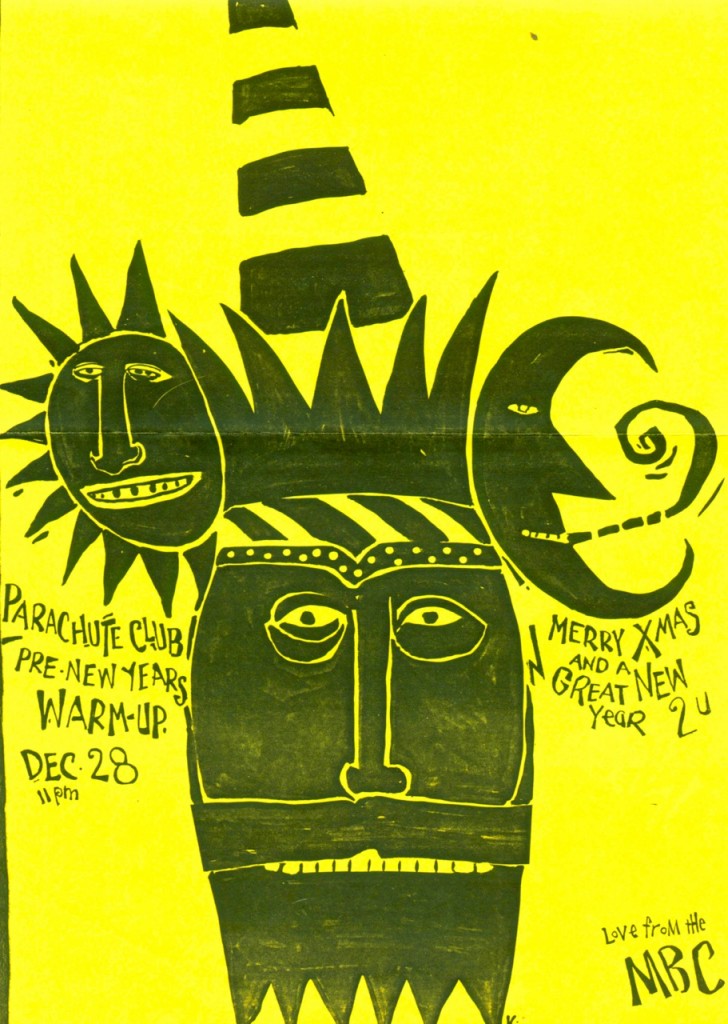
Poster for Parachute Club’s live debut, pre-BamBoo. Poster by Barbara Klunder, courtesy of Lorraine Segato.
Why it was important: “In the early ’80s, you still couldn’t drink on Sundays unless you were eating—restaurants would close at 9 p.m. or 11 p.m. on Saturdays, and gigs would end by 11 p.m.,” says Segato, also writer/director of 2001 documentary The Rebel Zone, an exploration of Queen West cultural history.
“So in many ways, the boozecans fostered an opportunity for different kinds of music and nightlife to emerge. What Richard and Patti did was take the vibe of the boozecan—a thriving, pulsating, really happening community feeling—and brought that to the BamBoo.”
At the time, Queen West itself was home to a flourishing arts community. The early ’80s recession had hit hard, so rents were relatively low, chain stores had not yet swooped in, and Queen west of University was filled with unique independent retailers, art galleries, new restaurants, and social spots.
“Queen Street was where the ‘new music’ was going to happen,” explains artist Barbara Klunder, an illustrator who drew the MBC’s invites, and went on to help define the BamBoo’s visual identity.
“Before that, it was folk on Yorkville, or blues and jazz clubs on old Yonge Street. The Rivoli also opened up on Queen Street around the same time [as the BamBoo], while Peter Pan had changed hands and become a cool place to eat. There was also the Parrot restaurant, with Greg Couillard as the first [local] celebrity chef. This was the zone of a whole new sensibility of cool international food [writer’s note: Le Select Bistro had opened nearby in the late ’70s], with music to match.
“The BamBoo had a mandate of world music and world food—basically the very opposite of European/white culture. The idea was a fun tropical nightclub, in both music and food.”
Influenced heavily by African art, Klunder had an aesthetic that matched O’Brien’s musical vision. She was at the core of the BamBoo’s marketing, from creating its logo to illustrating ads, menus, posters, t-shirts, giant murals, monthly newsletters (over 200 in total), and much more.
As customers walked in past the two painted palm trees that helped mark 312 Queen St. W., one of Klunder’s large murals adorned the brick wall just inside the BamBoo’s first set of gates. Her cheerful mosaics also greeted people. (The mural painted on the outside of the BamBoo’s easterly wall, which faced a parking lot, was originally by Runt. Other artists, including Fiona Smyth, would add to it over time.)
“A tropical garden path led you to a sparkly lit enclosed outdoor patio dining room, with bamboo and tropical plants growing amongst the patio tables,” Klunder describes. “The colours were mostly pink and turquoise to get that island feel right away.
“Then there was the double-door entrance over the floor mosaic of the moon, and you arrived inside a huge room divided into red restaurant booths on the left, and a long, long bar on the right, both leading to a stage. If you turned right as you entered, you would end up in the small pink dining room, which was always full. All through the club were corny 1950s lamps with naked ladies and jaguars, African masks, and mid-century tables loaded down with giant tropical floral arrangements. The walls were covered with either big versions of my artwork or changing art shows of local artists.”
“The aesthetics of the club were interesting,” offers multi-instrumentalist and producer Chris Brown, who started bussing tables at the BamBoo in the late ’80s as a high-school summer job, before playing organ and singing on its stage as part of Bourbon Tabernacle Choir.
“The Caribbean accouterments, mid-century furniture and lamps, and Ontario bamboo in the courtyard all conspired to create a Gilligan’s Island feel tucked into an oasis on Queen West.”
Inviting in every possible way, the BamBoo was relaxed, warm, and far from slick. Random parts hinted at an industrial past, including the outdoor fountain built atop the remnants of the building’s original boiler. A narrow metal stairwell led up to the Treetop, a Jamaican style bar ‘n’ BBQ that opened on the club’s rooftop in summer of 1984, expanding the BamBoo’s legal capacity to 500.
“During the summer heat, there was nowhere you wanted to be other than the Treetop Lounge,” says Klunder. “Think rum drinks and burgers at brightly painted barstools or coffee tables under the night sky and the CN Tower.”
“The thing about the BamBoo was that everything was great—the music, the food, the staff, the vibe, the vision,” says Segato. “It was known as much for its mix of food as for the music. You’d walk in and there was the feeling that you could be in Jamaica or Trinidad or some amazing beach bar in Thailand.”
The BamBoo’s menu, in fact, combined all of these cultural reference points, and helped put the nightclub on the map, as well as on best-of lists. Open six days a week from lunch until the wee hours, the BamBoo attracted a large and loyal crowd of food lovers, thanks to original chefs Vera Khan, who handled the West Indian fare, and Wandee Young, Thai-food innovator.
“Our concept was food from anywhere where there was a gorgeous beach, and so the Thai/Caribbean menu evolved,” explains Inge Kuuts, who worked at the BamBoo for almost all of its history, as a waitress, floor manager, and more.
“There was never a crazier, more stoned kitchen than that one, working way too hard in the constant overwhelming heat, serving more food orders than was possible to keep up with, and yet able to put out the best island-style food available in the city! People would come miles for the Thai noodles, and I have yet to have one better than the dish created by Wandee Young.”
Many Torontonians, in fact, experienced their first Pad Thai thanks to Young, who offered it first during her time at the BamBoo, and then when she opened her own restaurant, Young Thailand.
“I swear, when we started, nobody knew we sold food because everybody was coming for the music,” laughs Habib. “Within a few years, we became a very unusual nightclub in that we sold more food than we did liquor. Often people came for the food, had a seat, and would stay all night.”
The BamBoo’s menu—much of which is shared in the beautiful, best-selling 1997 book, The BamBoo Cooks, with illustrations by Klunder—barely changed an iota over the club’s history.
While Habib’s focus was largely on the menu, kitchen and staffing and O’Brien was the driving force behind bookings, it was their mesh of ideas and personalities that made the ’Boo work.
“Richard was a bit of a grumpy guy—he wasn’t all happy all the time,” offers Segato about O’Brien, widely known to be both contentious and charmingly passionate. “Patti was the one who I think was, in so many ways, the beating heart of the project, whereas Richard saw what it could do and why it was so, so important. Together, they were a formidable team who each took care of different pieces.”
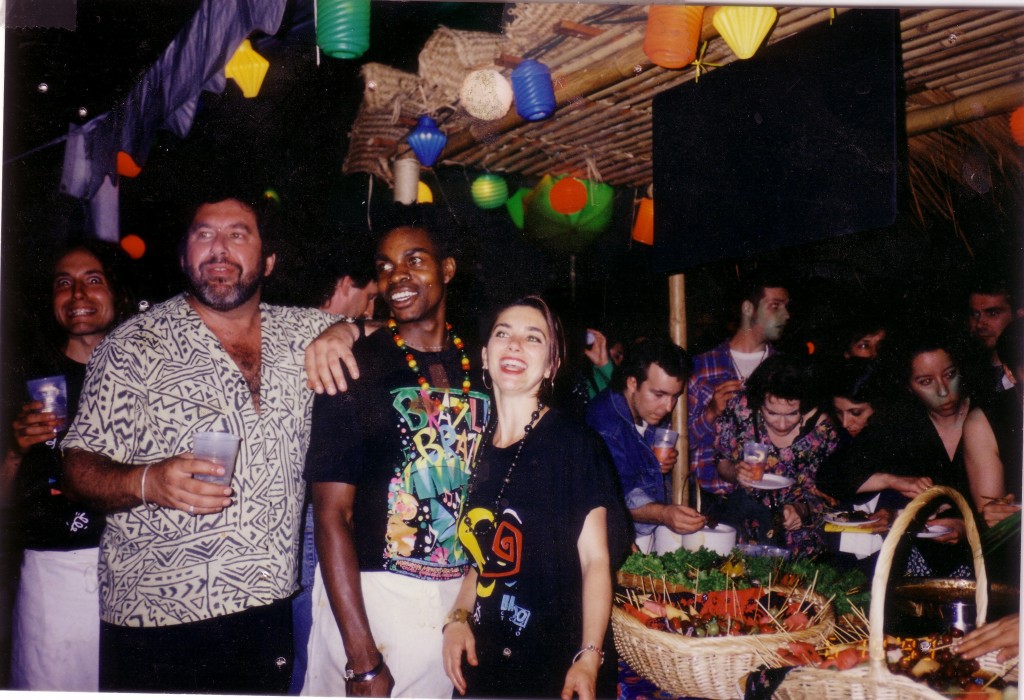
Richard O’Brien (left) with staff and friends on the BamBoo rooftop patio. Photo courtesy of Patti Habib.
Both were committed to making the BamBoo a meeting point of culture and communities, with live-music programming that was decidedly different than the rock lean of most downtown clubs. The BamBoo’s world-music policy brought together jazz, reggae, ska, funk, soul, African, and early hip-hop acts, among many others.
“While the BamBoo’s décor was laid back, with tropical lighting and Negril-type furniture, I believe that it was the general vibes from Richard and Patti that [most] celebrated this cultural mix, and made everyone feel like it was ‘home turf,’” proffers writer and Juno-winning dub poet Lillian Allen, who both frequented and performed at the club a great deal.
“The BamBoo created a community of performers and audience,” Allen adds. “It was, especially in the earlier days, a kind of love-in. The business model felt like it was culture first. They were about diversity and substance.
“I was involved with organizations such as A Space, Immican Youth project, and Truths and Rights, so I was part of a developing cross-cultural scene. I was also a member of De Dub Poets, with Clifton Joseph and Devon Haughton. The activities on Queen Street then were so vital and exciting. We were not only welcome, we were sought-after.”
Segato also appreciates the club’s approach to this day.
“I call BamBoo the hub, really,” she tells me. “It was the centrifugal force of any of the world music that was starting to pop along Queen Street. Of course you had The Cameron, The Horseshoe, The Cabana Room and a few other places—Billy [Bryans, Parachute Club co-founder and prolific producer/musician] used to say that he rolled his drum kit up and down the street—but they all kind of serviced different community-oriented projects. One was more performance art, another was art-school bands, you had a more blues-oriented club, and so on. But the BamBoo itself… everything generated circles around there once it opened.
“It was a place for everything that was remotely ‘world’ music—reggae, funk, anything that serviced the immigrant communities that had come to Toronto and were basically holding most of their events outside of Queen Street. If they came downtown, they came to the ‘Boo. I wanted to be at the BamBoo because you could see it was at the forefront of a new era of music in the city.”
“The BamBoo was pivotal in providing a venue where the music of the African diaspora outside of its North American innovations found a downtown place of expression,” agrees David Barnard, former Program Director of influential community radio station CKLN and host of Dr. Feelgood’s Blues Emporium.
“Nobody else was doing that on the scale that the BamBoo did at that time. Because the BamBoo was larger than The Rivoli, Cameron House, and the Beverley Tavern, rather than compete with them, it augmented the street’s musical vibe. It added so much to the existing music scene.”
There were close ties between the BamBoo and CKLN, which launched on the FM dial the same year as the club opened. The station’s jazz programmers—and hosts of shows like Diasporic Music, Socalypso Sounds, Latin Party, and Reggae Showcase—played many of the artists that O’Brien booked. The ’Boo was also a key venue and participant for most years of CKLN’s signature Street Crawl event, which brought 15 bands to five clubs for one admission price. (Full disclosure: as CKLN’s Development and later Program Director, I helped produce the event.)
Perhaps most significantly, the BamBoo sponsored CKLN’s weekly Sounds of Africa show, launched in 1986 by hosts Thad “Thaddy” Ulzen and Sam Mensah, and that relationship continued for many years. Under the production company name Highlife World, Mensah and Ulzen also brought many African artists to perform in Toronto.
“There were hardly any clubs playing African music,” recalls Mensah. “Richard O’Brien was a great fan of Ghanaian highlife music, and soon got us working actively to bring African artists to play at the BamBoo.”
“Ours was a purely collaborative effort to get African music on to the cultural landscape of Toronto, and in Richard and Patti we found an interested and willing pair,” adds Ulzen. “Initially, we had a few Tuesday night acts, which we advertised in the African community to get things started before we were all ready to try bigger acts on weekends.”
As the founding duo behind Afrofest—now in it’s 25th year and long organized under the Music Africa banner—Ulzen and Mensah brought dozens of incredible artists to the BamBoo stage, including an event with legendary South African trumpeter Hugh Masekela.
“That was a particularly magical night,” writes Ulzen by email. (He is now a psychiatrist who teaches full-time at the University of Alabama, part-time at the University of Cape Coast in Ghana, and has just published first novel, Java Hill: An African Journey.)
“The ticket line went halfway around the block, and Sam and I literally had to beg to get in. It was so packed; everybody and their brother had a reason for getting to the head of the line!”
“In 1989, we reached an agreement with Richard to make the BamBoo the sole venue for Afrofest,” adds Mensah (now an economist who teaches at the University of Ghana, and is founder of the Jazz Society of Ghana). “This was a significant year. Many important African artists played at the BamBoo under Afrofest, including Sonny Okusun from Nigeria, Kanda Bongo Man from Congo, and Native Spirit, Okyerema Asante, and Sankofa, all from Ghana.”
Like many, Habib counts the appearance of Masekela as among her favourite of BamBoo performances, and also mentions highlights including appearances by Fishbone, local pan-African band Siyaka, R&B act Soul Stew, vocal powerhouse Molly Johnson, and Toronto-based reggae artists including Leroy Sibbles, Messenjah, and Sattalites (whose 1987 album, Live Via Sattalites, was recorded at the BamBoo.)
Habib also reminds me that the BamBoo took public stands on social issues, with its owners speaking out against apartheid in South Africa and initiating a Queen Street club crawl in support of pro-choice advocate Dr. Henry Morgentaler.
“I made it a point to organize events at the BamBoo to bring out my communities, and consciously supported its fantastic programming,” states Lillian Allen, who launched her second album, Conditions Critical, there.
“It became a hip, dynamic place for all sorts of diverse artist-driven culture. De Dub Poets organized many, many events there, as did Ahdri Zhina Mandiela [with whom Allan brought in British dub poet Benjamin Zephaniah]. Truths and Rights did a lot of gigs there. A lot of experimentations happened, too.”
“Because of the BamBoo, a lot of people worked together who wouldn’t generally have had the chance to,” agrees Segato, citing a shared project between herself, Billy Bryans, Rough Trade bassist Terry Wilkins, and “Truths and Rights’ charismatic front man, Mojah.”
Post-Parachute Club, Segato performed both solo at the club, and with collaborators also including John Oates (of Hall & Oates) and Micah Barnes.
“The stage was kind of small, and it was hot and sweaty,” she recalls. “I mostly remember summer nights with people jammed in there, dancing away, totally anything goes. The best gigs I ever did, I have to say, were at the BamBoo because the club was big enough that it had a real vibe if you filled it, but it was still intimate. It was the hottest club.
“In many ways, like the El Mocambo would have been for rock ’n’ roll music in the ’60s and ’70s, the ‘Boo was that in its time; you always had the feeling that something amazing was happening there.”
Not only was Richard O’Brien a strong music programmer, he also had a keen sense of which independent promoters to embrace. Innovators like Elliott Lefko, Lance Ingleton, Jones & Jones, and Jonathan Ramos of REMG all booked in shows.
In 1987, Dark Light Music’s Serge Sloimovits staged a jazz festival, with appearances by acts including Cecil Taylor, World Sax Quartet, and Toronto’s Shuffle Demons. Barnard also recalls seeing The Art Ensemble of Chicago—“I couldn’t sleep that night as a result.”
Like Afrofest, the Toronto Downtown Jazz Festival has early roots at the BamBoo. “The first time I worked at the BamBoo was through the DuMaurier Jazz Festival, circa 1988,” says Chris Brown.
“I remember as a busboy watching Brian Murphy kick organ bass with Eugene Amaro and my life was changed by it. I was a major fan of Defunkt, and they had me hang out with them for their stay in Toronto and shows at the BamBoo. It was seminal for me; Joe Bowie became a serious musical mentor, and I ended up working at the club on and off for four years, first as a busboy and eventually waiting tables.”
Shuffle Demons’ charismatic and versatile sax man Richard Underhill recalls the band playing regularly after their jazz fest dates for Sloimovits.
“I was also lucky enough to play with the late Mozambican bass player Jamisse Jamo at his monthly Africa Night jam sessions, which was a joy and a great learning experience.” (Jamo’s band included African music veterans like Quammie Williams and Kobena Aquaa-Harrison.)
He, like nearly everyone I speak with, points out that the BamBoo reflected the change in Toronto’s population. The club was nearly as multicultural as the city itself, and was welcoming to all. According to many, there were zero fights in the club’s long history despite its lack of air conditioning and frequent sauna-like conditions.
“There was a great vibe at the BamBoo that radiated out from the staff, and included the audience,” says Underhill. “It was one of those wonderful places where you felt that the Canadian cultural experiment was really working, where people from all different cultural backgrounds came together and got down with each other.”
“The BamBoo was mix-up, mix-up,” agrees Barnard. “It was a nearly perfect realization of Pierre Elliott Trudeau’s concept of a multicultural Canadian society.”
“The BamBoo was and will always be one of a kind,” summarizes reggae artist and founder of The Canadian Reggae Music Awards, Winston Hewitt.
“All of us reggae artists, as well as supporters of the music, just loved to be at the BamBoo. There was so much good talk on the street about the club that, before you went there, you already knew what to expect. Everyone was welcome, no matter what colour or creed.”
Who else played/worked there: Artists from near and far wanted gigs at the BamBoo.
“The sound was always great, the beer cold, food good, and you really felt respected as a musician,” explains Underhill. “It was just the right size, with a good vibe and a cool staff. Patti was such a joy to deal with, a real sweetheart.
“And,” he adds, “When you played, you got paid!”
The BamBoo’s size, sound and staging made it a next-level club for local artists on the rise, and a great intimate spot for internationals to connect with their Toronto following.
“Music was always front and centre,” emphasizes Chris Brown. “The Last Poets, Jimmy Witherspoon, The Lounge Lizards, King Sunny Adé, George Clinton, David Byrne, and Slim Gaillard all made stops on that stage. It also nurtured our incredible domestic reggae and ska scene, [booking bands like] 20th Century Rebels, Skatones, and Kali & Dub.”
Before Bourbon Tabernacle Choir started to tour regularly, Brown could often be found five or six nights a week at the BamBoo. When not with tray in hand, he guested on keys with a variety of reggae bands. It’s a little known fact that O’Brien helped him get there.
“When I was working as a busser one summer, Richard pulled me into the office and said, ‘What’s this I hear about you buying a Hammond Organ?’ I told him I intended to when I could afford it. ‘Any 17-year-old who is buying a Hammond is trustworthy,’ he said, and cut me a cheque for $800 on the spot, which I paid off out of my wages.
“Richard was kind of like Fred Flintstone: beneath the gruff was this incredible soul.”
The Bourbons as a whole benefited greatly from their connection with the club.
“The BamBoo was one of the first places we began drawing a crowd, and I believe at least four of us worked there as our day job, too,” says Brown. “It really opened Toronto for us, and got us working at clubs like the Horseshoe and The Diamond. The music we witnessed there nightly, and the artists we met had a massive effect on us. It’s extraordinary; I can’t really think of a parallel.”
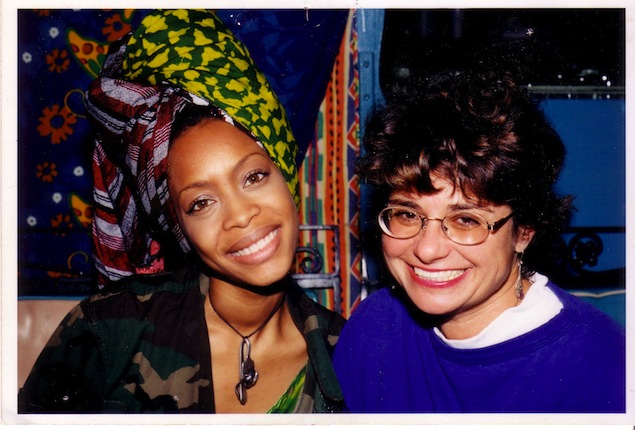
From top: Bunny Wailer, Screamin’ Jay Hawkins, Dizzy Gillespie, and Erykah Badu with Patti Habib. Photos all courtesy of Habib.
“Seeing Buckwheat Zydeco for the first time there stands out,” says Barnard. “An accordion can be funky, ils sont partis! Also, it’s taken for granted now, but the chance to see locally based Leroy Sibbles, Willie Williams, Lillian Allen, Clifton Joseph, Jayson, and many more in those early days was very influential on current generations of performers.
“I saw Whitenoise, led by vocalist/sax player Bill Grove, on many occasions,” he adds. “NYC may have had James Chance and Defunkt, but we had Whitenoise. I thought Bill’s bands kicked more ass.”
Toronto’s local soul and acid jazz scene represented too, with appearances by bands like Jacksoul and Bass Is Base. By the late ’90s, Soul 4 Real Mondays, with host Wade O. Brown and DJs Christopher Michaels and Everfresh, were the BamBoo’s biggest weekly draw.
Also part of the BamBoo’s programming mix were countless community events, Film Festival parties, City-TV events, book launches, weddings, and more. Canadian celebs, artists and industry people—like Aykroyd, Sibbles, Bruce Cockburn, Buffy St. Marie, Moses Znaimer, Marcus O’Hara and sisters Mary Margaret and Catherine—were often in attendance.
“The BamBoo was the most fun job I ever had,” declares longtime waitress Inge Kuuts. “The staff had a really big spread in ages, everyone was a character in some way, and we got along great. We worked together and partied together. Patti and Ricci were accommodating to their staff, and would always help you out if they could.”
According to Lillian Allen, “The staff and serving personnel had this vibe of peace, love and respect, with a certain kind of sizzle.”
People like Andy Joyce, John Pigani, and PJ Taylor aided in the BamBoo’s initial construction, and went on to contribute in other roles. Boys Brigade band member Billy “Bucko” Brock was an early presence on door. Chef Stash Golas worked alongside Vera Khan in the kitchen for years. (Both now live in Costa Rica, where they each own restaurants.) Other chefs, like Marion Robinson and Joe Davies, were also key. Longtime general manager Jennifer Halpin worked alongside veteran bartenders and servers like Wayne Graham, Parker Ng, Brian Sam, Sandra Coburn, and Karen Young—all very familiar faces to BamBoo regulars.
Habib also credits artist Annie Jaeger, the BamBoo’s bookkeeper for its entire history (“she was so very important; the sanity keeper of the office,”), and speaks fondly of long-serving waiter, Michael Flaxman, now owner of Boo Radley’s on Dupont.
“Michael used to serve the area we called Cambodia, which was usually hot, packed, and hard to get through,” describes Habib. “He would gather up trays of beer and rum and cokes, and somehow walk his way through. He was the nicest, most polite waiter, and sold the most of anyone.”
“For the most part, the staff was like stowaways on a ship,” says Brown. “We came from everywhere, and lifelong bonds were formed. There was a sense of a separate universe about it, and things felt familial. The BamBoo prepped me for life as much as anything did.”
Brown now divides his time between Wolfe Island and NYC where he records and performs with many people he met at the club, including frequent collaborator Kate Fenner.
Kuuts, who now works on the retail side of the restaurant industry at Nella Cucina, speaks of another annual highlight in the BamBoo staff calendar.
“We used to have a float in Caribana, and take mushrooms to get through the day of dancing. Caribana night at the ’Boo was super packed, super fun, and super hot, hot, hot!”
“In the old days, when Caribana ran down University, if you had a good float with good music, you had a huge procession because people were allowed to join in, which is what it’s supposed to be all about,” adds Habib. “It wasn’t just a parade; it was a party on wheels.
“Because the BamBoo had money, we could afford a second generator, refreshments on board, the décor, a big band and sound system. We partnered with Shadowland—theatre artists who live on the Island—and they would always come up with a theme. Jack Layton and Olivia Chow would always come along. At the end, we would turn off and go down Queen Street, and everyone would come out of the shops to wave. Caribana used to be our biggest night of the year; it was just so wild.”
What happened to it: The BamBoo began to falter in 2000, after O’Brien was paralyzed by his first serious stroke. He was mobile in a wheelchair, but spent much of his time accessing rehabilitation, meaning Habib had to take on much of the work. Business remained steady, but Habib found the workload difficult.
When it was announced in July of 2002 that the BamBoo would soon be closing, customers were surprised, and many made assumptions.
“People always seem to think that we sold the business for big money, but we didn’t,” Habib divulges. “We didn’t have the chance to sell it.
“I did a deal with my landlord, because he knew that I was having troubles without Richard there and wanted out. He gave us a new 10-year lease, but with a handshake. [With his knowledge], I met with a listing agent, and we put [the business] up for sale in May. On July 1, the day our lease officially expired, I got a phone call telling me that the landlord had sent a registered letter, giving us 90 days to get out.”
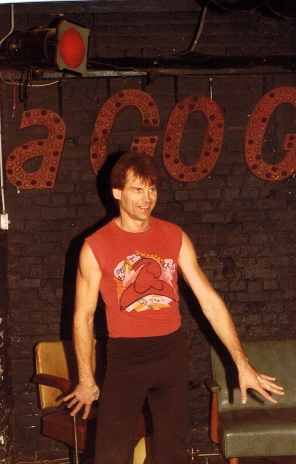
A BamBoo regular dances in front of the venue’s beloved A-Go-Go sign. Photo courtesy of Patti Habib.
The BamBoo closed with an October 31 bash, dubbed BooHoo. Performers included Sattalites and Billy Bryans.
By then, chain stores including Le Chateau had moved to the strip, rents had skyrocketed, and O’Brien was knee-deep in plans to open Bambu By The Lake on Queens Quay, near Harbourfront. Sadly, his involvement lasted less than a year, and he lost most of his life savings. O’Brien suffered a second massive stroke in 2007, and passed away. His friends paid tribute in many ways, including a blog devoted to Ricci Moderne.
“I miss having Richard around,” says Klunder, who remains both prolific and versatile as a visual artist. “He was notoriously rude, but funny. The club was his brainchild and his child.
“I miss the BamBoo’s particular relaxed-during-the-day cool, and be-there-or-be-square nightclub acts, with line-ups around the block for many gigs. It was our cool, cultural community centre, a place to even bring the kids, a place for our slightly wild, musical, artistic gang. There is nothing like it now.”
Lorraine Segato—who agrees “there has been nothing like the BamBoo ever since”—also remains very active as a multi-media artist. She’s currently completing her third solo album, expected in fall, and has written a one-woman show, called Get Off My Dress, also set to premiere come autumn.
Habib is semi-retired from the club/restaurant business, but is actively involved in the city’s cultural goings-on.
Award-winning alto saxophonist Richard Underhill is busier than ever, but he too longs for the BamBoo chill.
“I miss the food, the Red Stripes, the downtown Caribbean feel, the cultural meeting point and the way your sphincter relaxed when you walked into the place,” he writes. “The BamBoo was a beacon of tranquility in a crazy city, a home to top-quality music and great people, a place where all were welcome and most were cool.”
Barnard, a consultant in the Department of Canadian Heritage since 2008, concurs, and raises the topic one.
“Places today seem uptight to me,” Barnard offers by way of comparison. “There is also no club like the BamBoo now in terms of its programming. Ironically, it feels like the city could really use a unifying entity like it to help galvanize creative energies again.”
Charles Khabouth and his INK Entertainment opened Ultra Supper Club at 312 Queen St. W. in 2003. It ran for nine years, and was renovated and re-launched as Cube last year.
Thank you to participants Barbara Klunder, Chris Brown, David Barnard, Inge Kuuts, Lillian Allen, Lorraine Segato, Patti Habib, Richard Underhill, Sam Mensah, Thad “Thaddy” Ulzen, Winston Hewitt, and to Keith Holding for permission to include the clip from his Bar Life show.

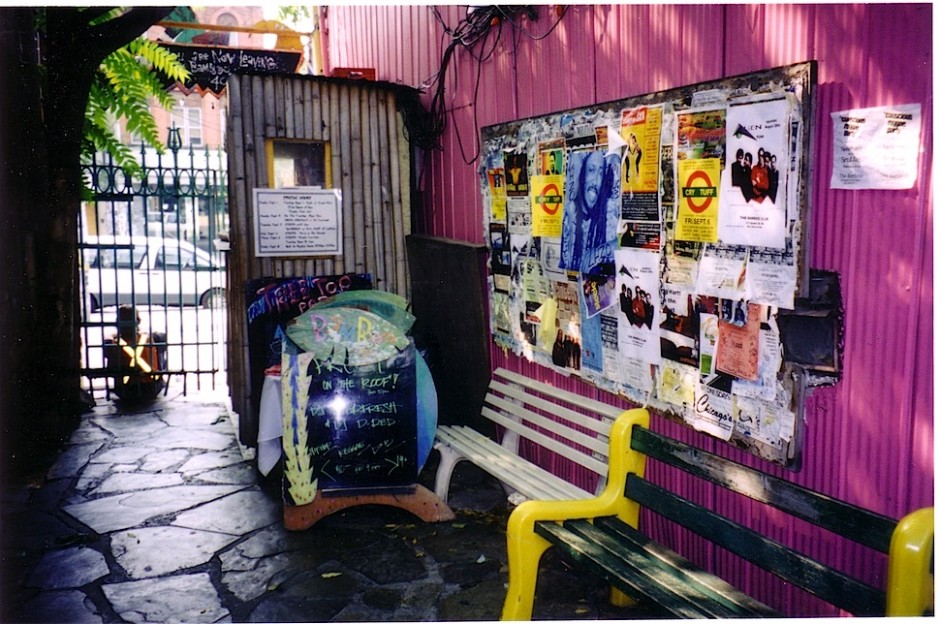
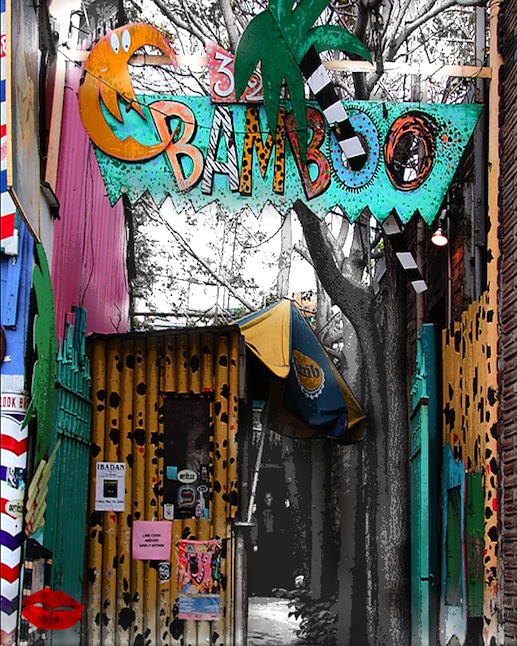
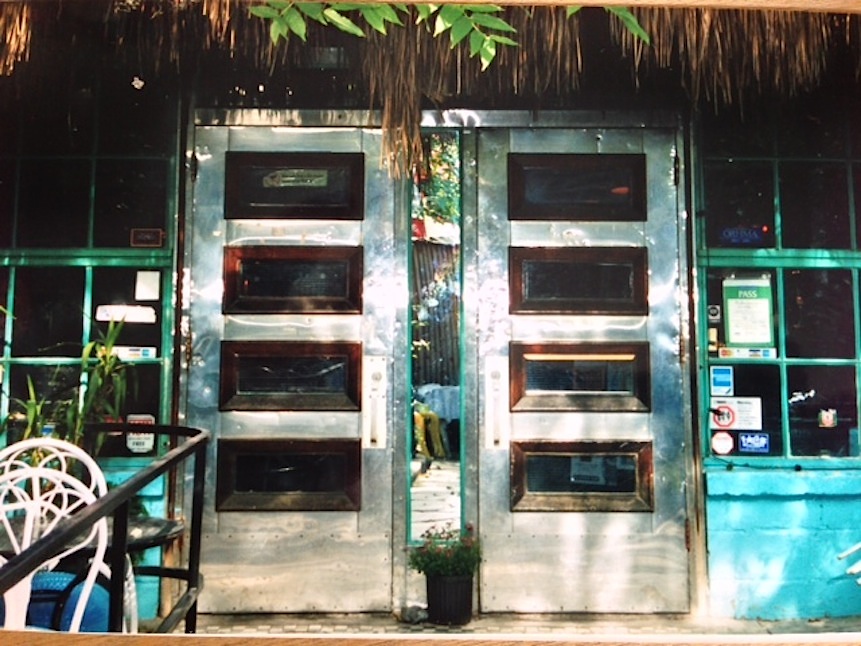
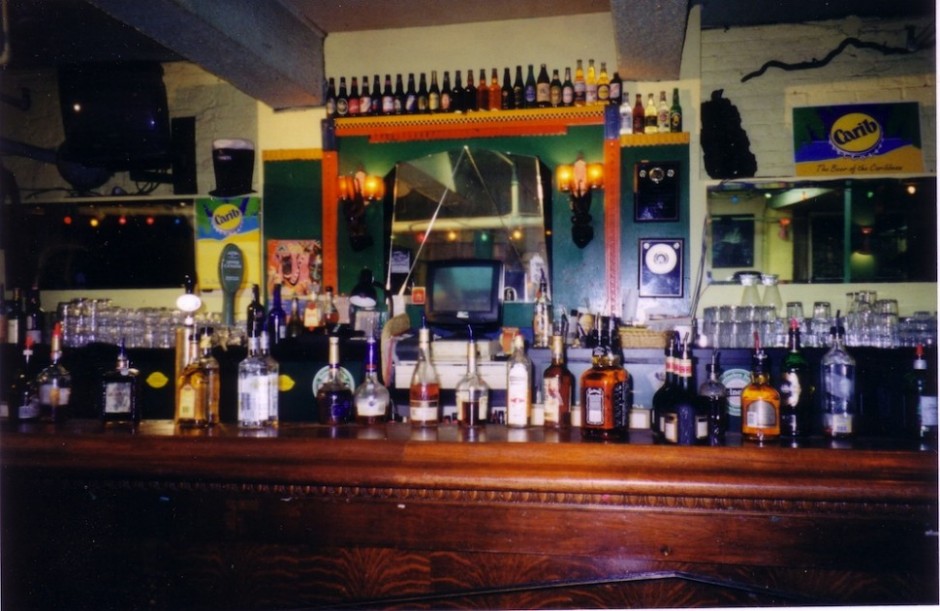
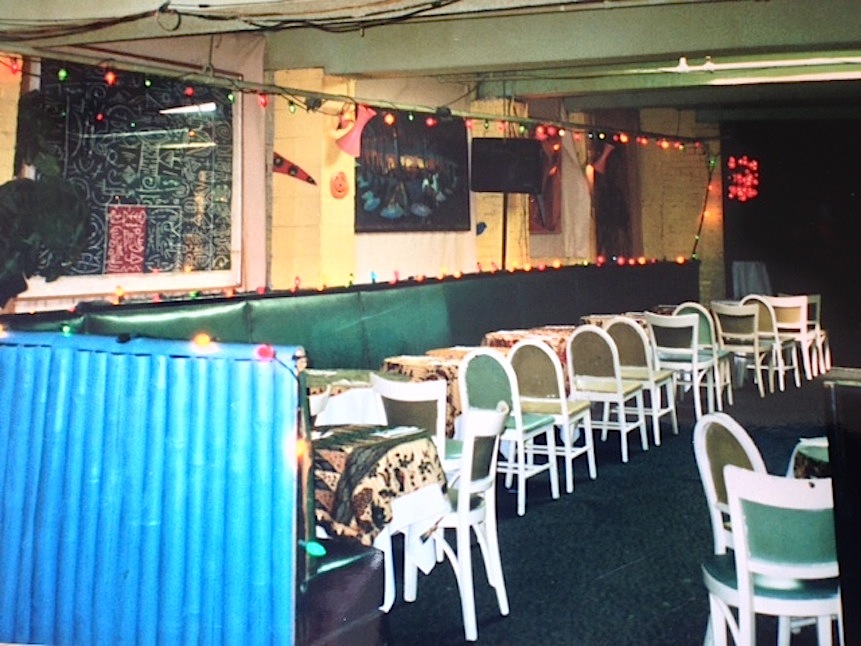
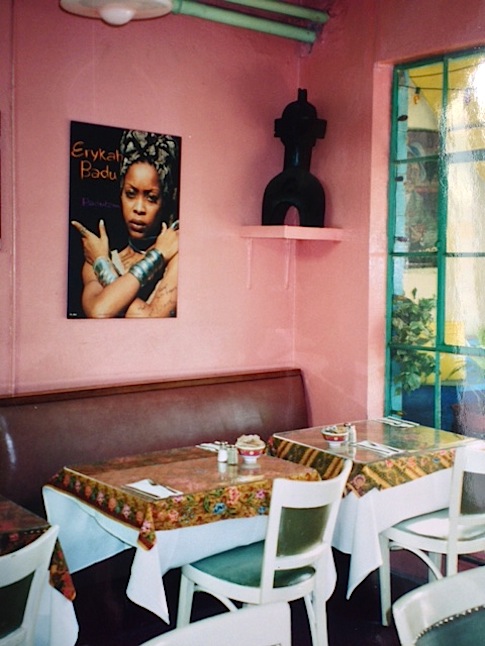
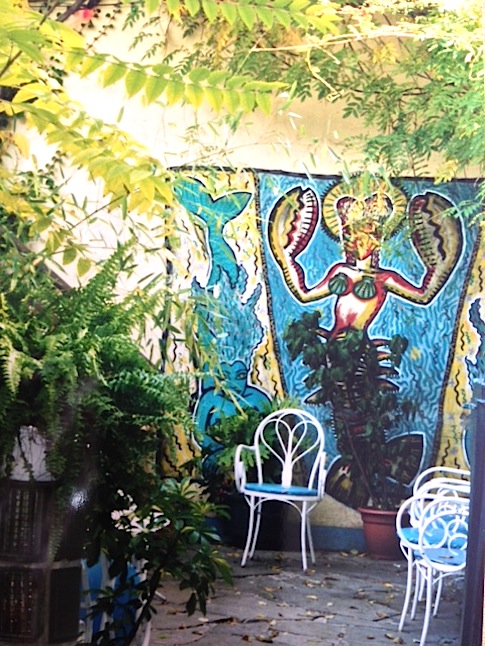
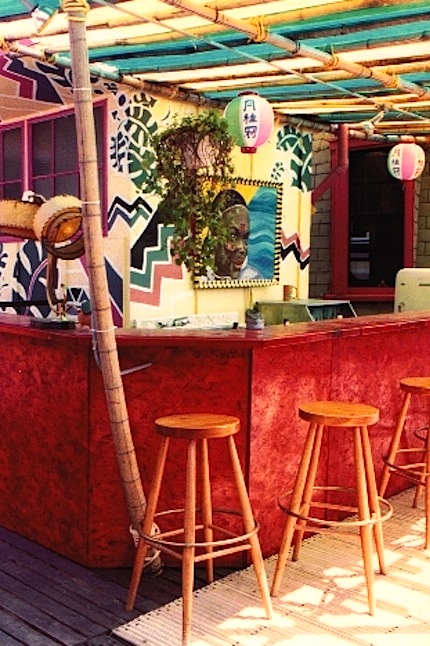
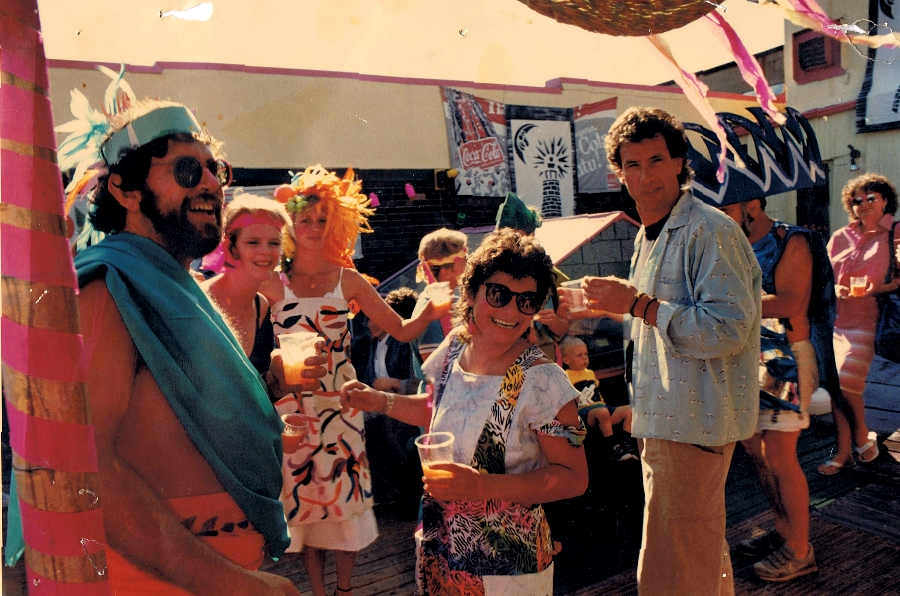
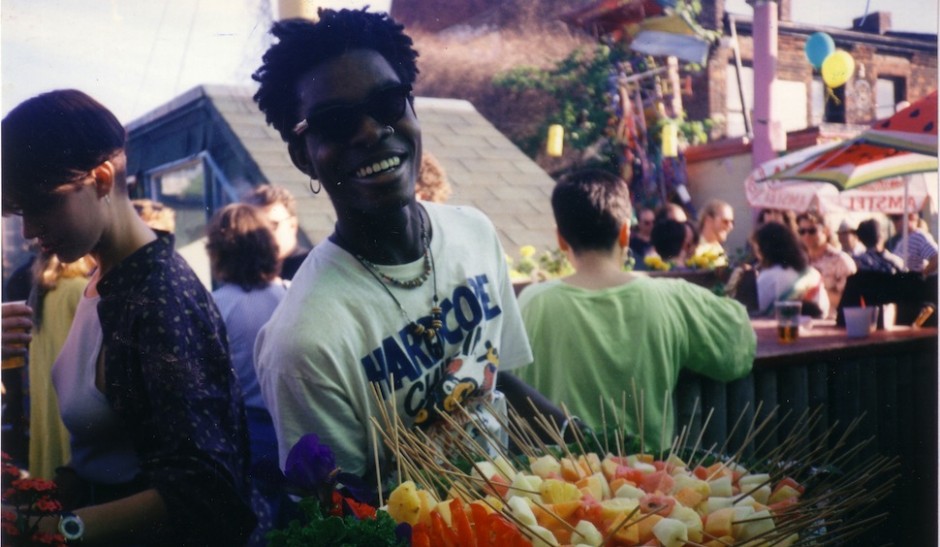
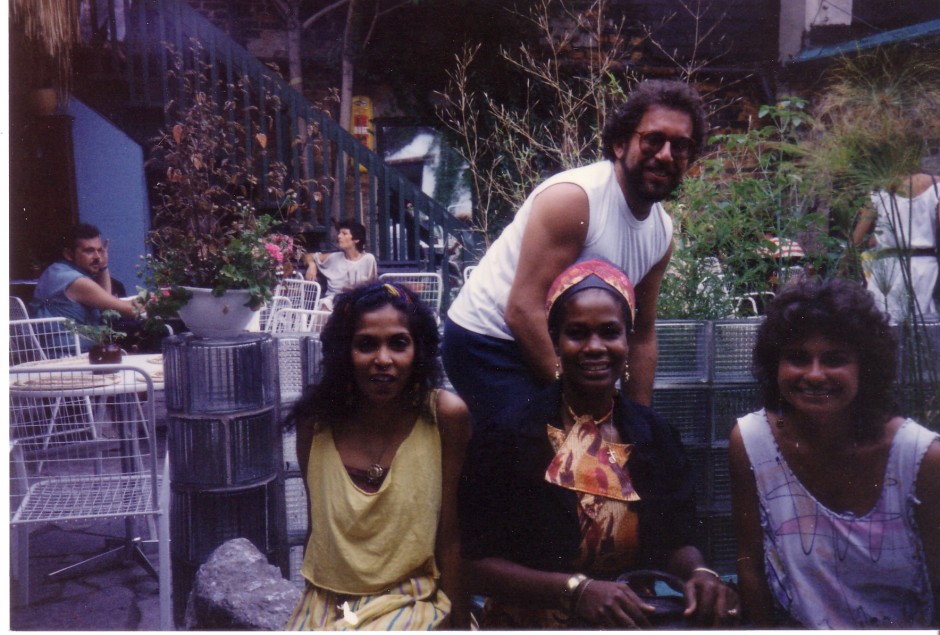
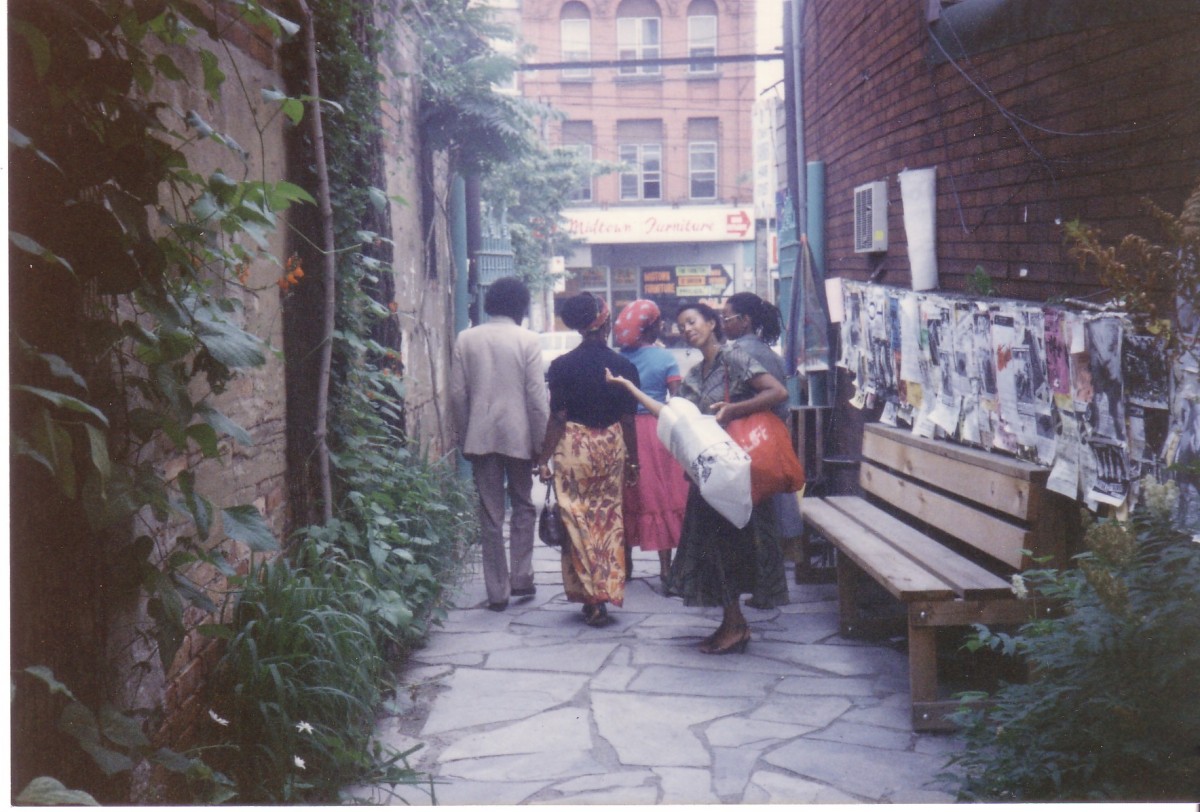

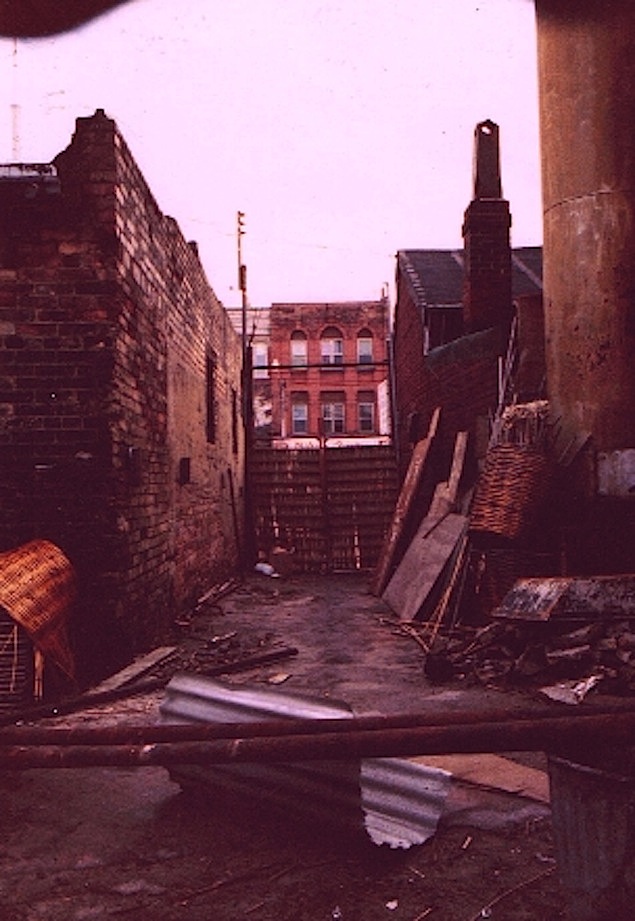
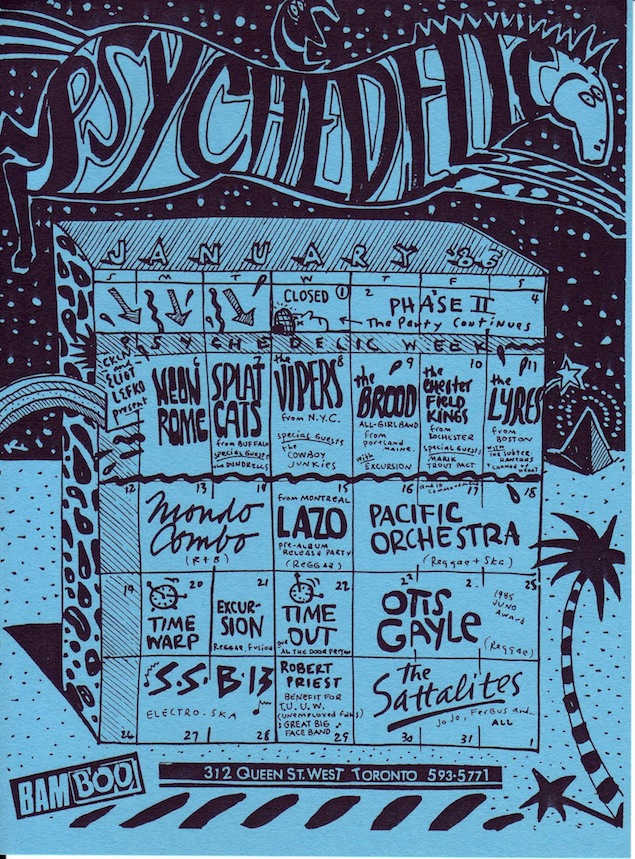
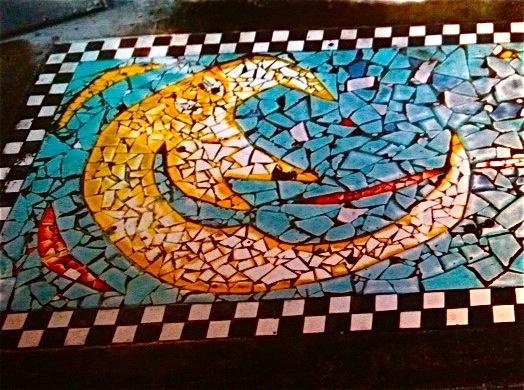
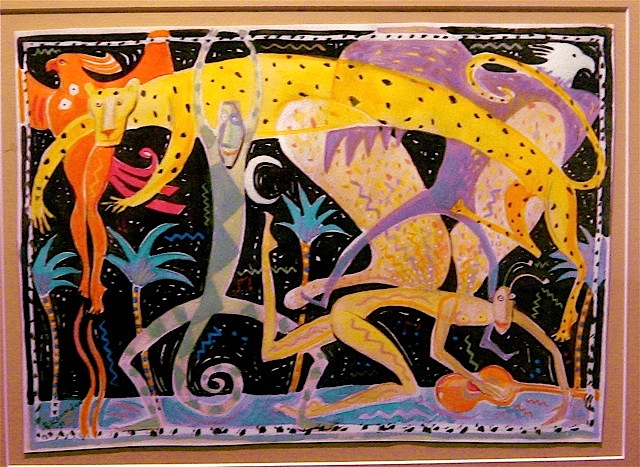
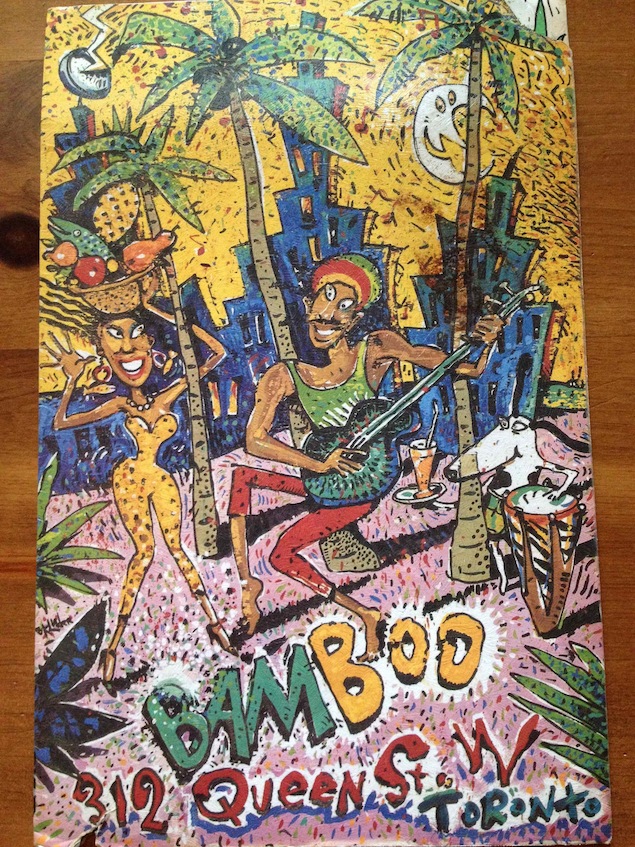
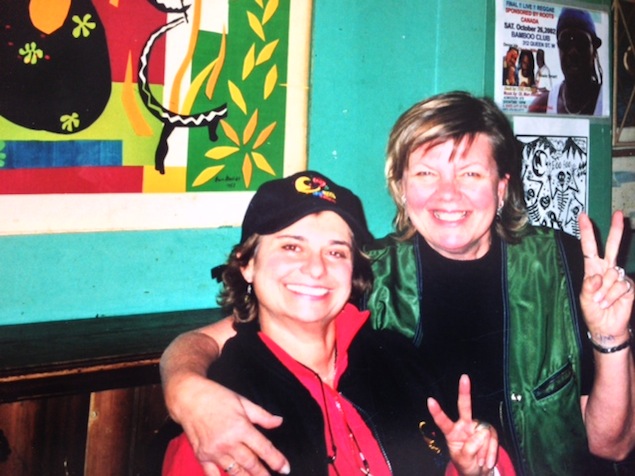
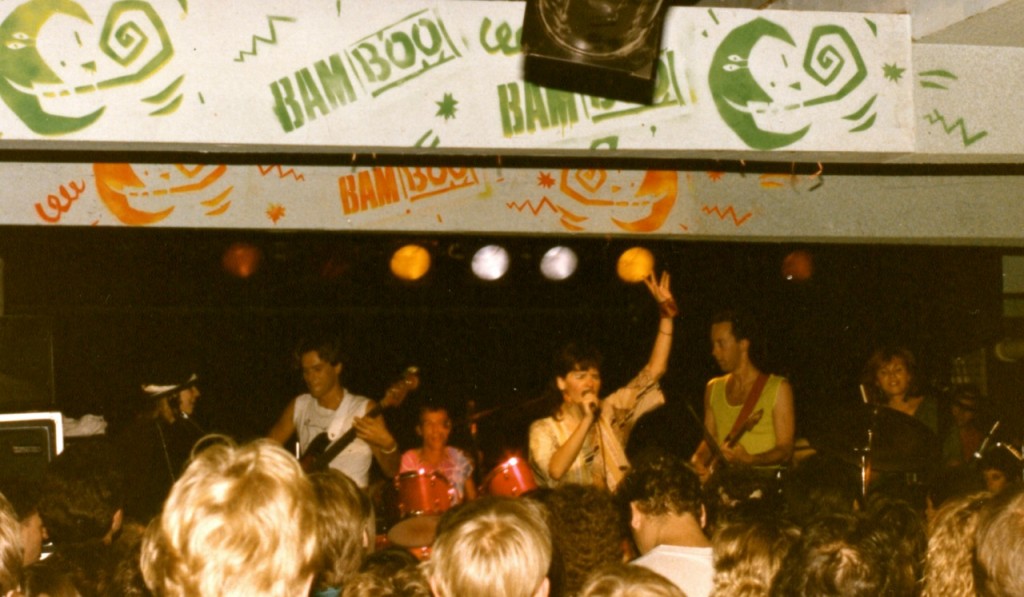
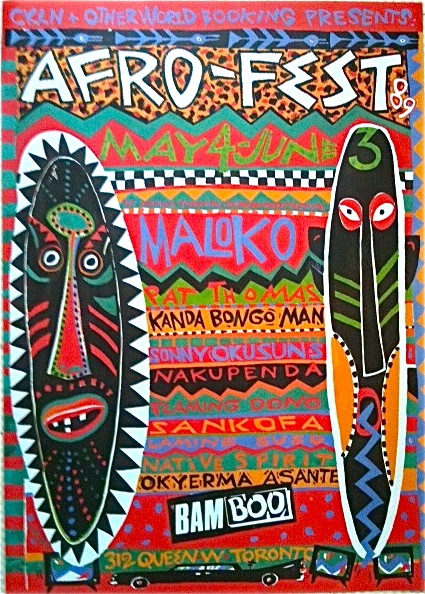
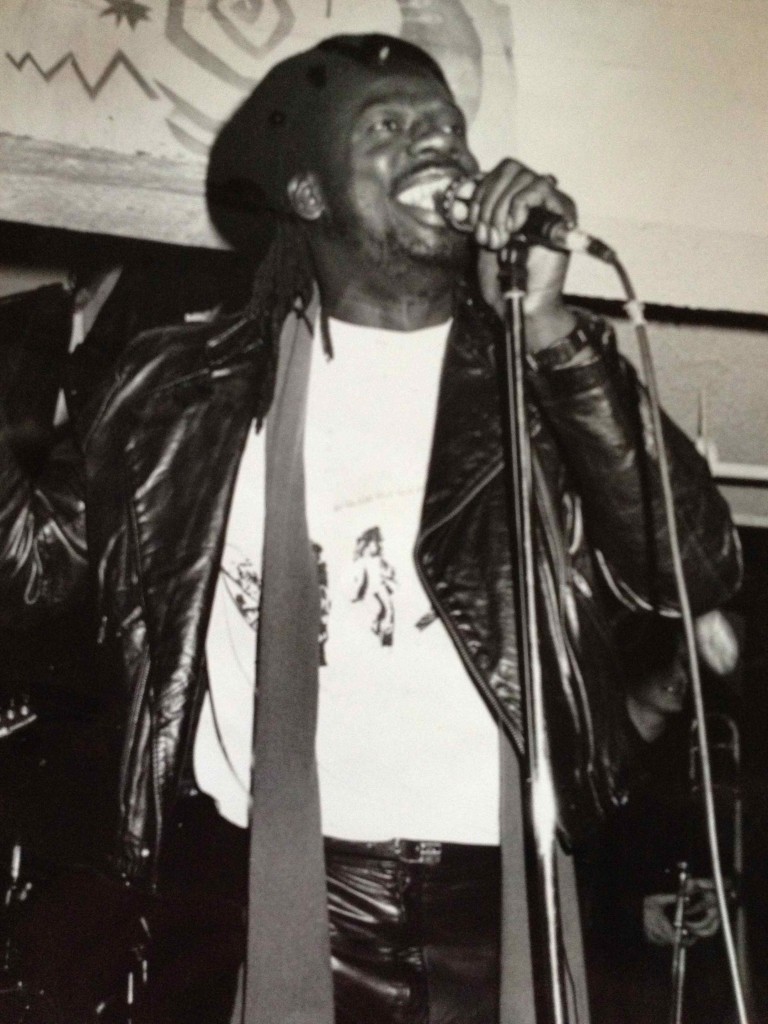
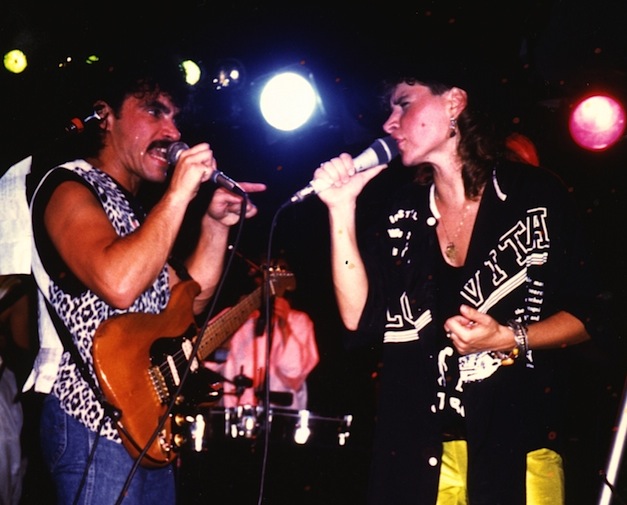
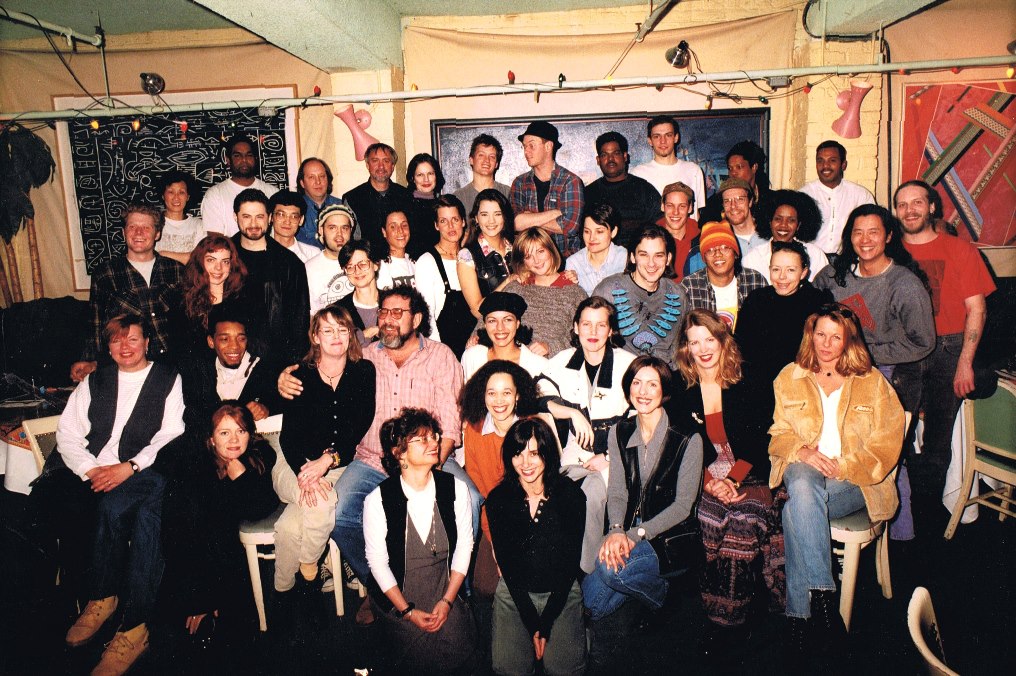
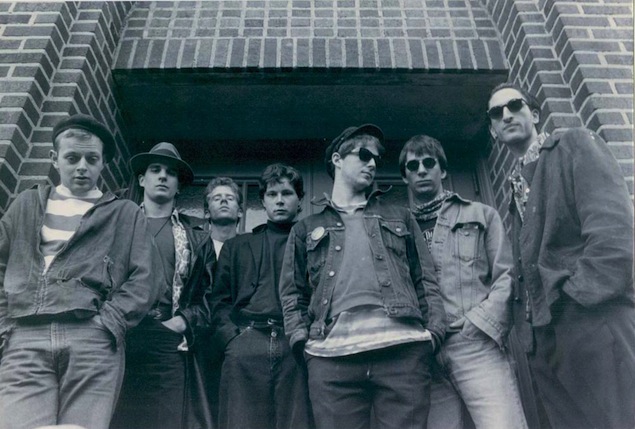
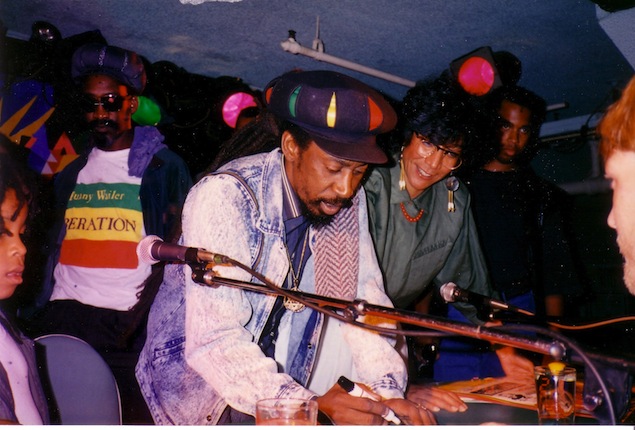
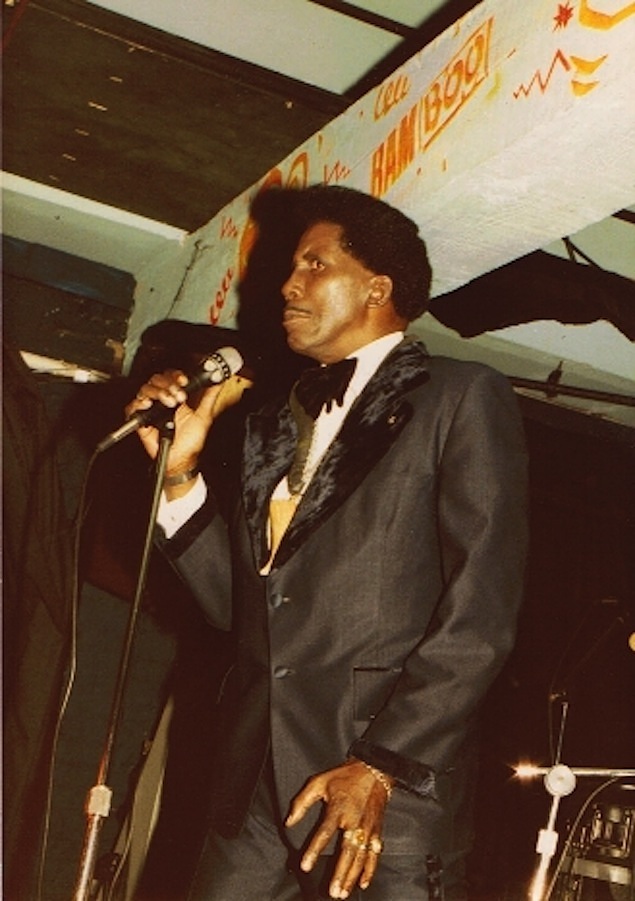
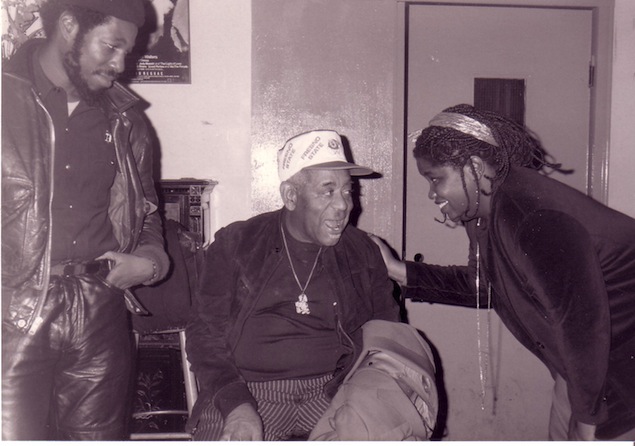

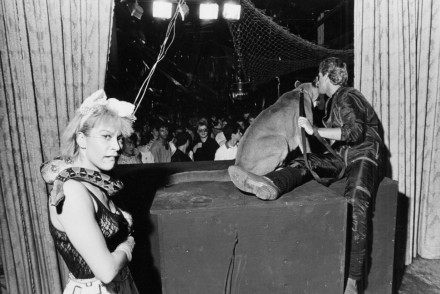
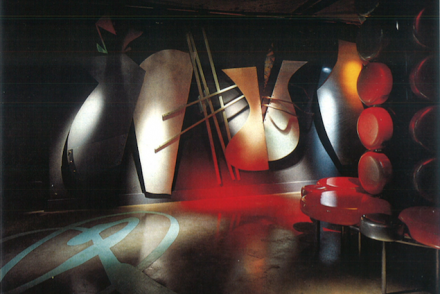
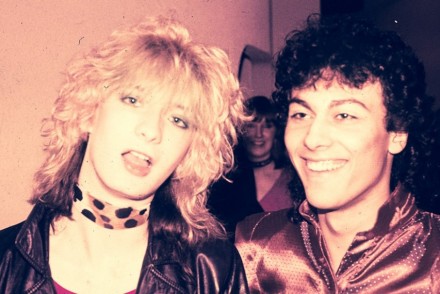

18 Comments
11 years too late? Maybe…..
I worked the last night behind tbe bar at the Bamboo, I am very proud to say. I will never remember a job so well or so fondly. Thank you for hiring me Patti and giving me the absolutely best and most wonderful experience of being a bartender at the Boo
[…] “In 1984 we added a number of their Lao and Thai dishes, like pad thai, ping gai etc, to what we called our global comfort food menu. Chef Noy, still in our kitchen, is a member of the original family. The only restaurant in Toronto serving Thai food around that time, to our knowledge, was the original Young Thailand, the Rivoli and the BamBoo.” […]
I still miss The Boo. All the great food, all the great funky music, the fun and very cool vibe and the absolutely fantastic late night big slice of chocolate cake. I have that wonderful cookbook and treasure it. I was lucky to have many years enjoying the Bamboo right from the first year. Great memories.
What about Madcaps – a blues bar down the street. Does anyone remember that place?
Bamboo club was my hang, spent many nights there- Queen st will never be the same, great to be there at the time of this great place with great people to hang with.
OMG my girlfriends and I used to love going to see Fujahtive at this club. They were so good not to mention good to look at!
I saw the Michel Petrucciani Trio ply at the Bam Boo on Monday 20 August 1984 with my friend Wendy. I was sitting less than 2m away from the great man. I mention it for the record – I cannot find any other reference to Petrucciani playing in Toronto that year.
The best Pad Thai. I have never found better in the city. My toronto musical roots are tied to the Bamboo. Ahh, I miss that place. Thank you to all that served and gave.
I played in a band called Bop (Harvey) in the mid eighties and Bamboo was one of our favorite clubs. We were from East Lansing Michigan (MSU) and going to Toronto and playing this awesome club was an amazing experience!
[…] Oh, the 80s! A former laundromat on Toronto’s Queen Street became — from 1983 to 2002 — a fantastic bar and restaurant, with a lively rooftop scene perfect on a steamy summer’s evening. Here’s its history, and an excerpt: […]
I worked at the BamBoo bussing tables 1990-92 while also working as an actor in Toronto. It was such a fun and exciting place to be, I actually looked forward to my shifts. We worked really hard because the place was always packed. There were so many amazing bands night after night, I remember hanging out there even when I wasn’t working.
I lived around the corner and worked at Attic Records. Katrina and The Waves made their North American debut at The Bamboo.
Just found a book of matches from the bamboo. Memories came a floodin. Awesome article.
I practically lived at the BamBoo and Diamond Club from 1984-1987. I have great memories of so many of my friends that worked there. Al and Chris that worked at the door who lended an easy down to earth first impression when you walked in. Andy who I believe was part owner and his friend Rocky who owned Fab a really cool clothing store right next to the BamBoo. Then there was Johnny who owned and ran the Rendezvous snack bar at the back of the club. Johnny always had local artists shows behind his counter. When we needed a breather from all the energy we’ld escape to the secret or not so secret room above the boiler in the back of the Rendezvous. I also remember White Roots week booked by Andy once a year. It was a time and place of fun, diversity, and joy.
I moved to Toronto from Montreal in 1984. Being used to the casual joie-de-vivre nightlife in Montreal I was searching for the same feel in Toronto. I not only found it at the BamBoo, but the BamBoo surpassed the feel on so many levels. Toronto was growing in so many ways financially and commercially. The BamBoo was a place where you let that business vibe at the door. When you crossed into the laid back atmosphere you became more yourself and the real you thrived in that atmosphere. Warm And Loving Memories THANKS
I still call the Boo the best bar in the world. I miss it greatly. Started going there in ’85 or so. Went to university out of province but came back to work in T.O. and party at the Boo- sometimes not even waiting to unpack! I practically lived in the Treetop in the warm months- I absolutely loved it up there. Who remembers Killer Kool-aid? The vibe was cool, unique and never duplicated. It was a complete self-contained world with Barbara’s art, kitschy furniture, great food, friends and music. It also has a special place in my heart for the summer of 1988 – I met 2 fabulous women there and let’s just say the 3 of us spent a summer I’ll never forget
Was just thinking about BamBoo the other day, played some great shows there. I went back once or twice when it was Ultra but it didn’t have the same vibe.
All comments in the string below have been republished from their original appearance on The Grid website. We’re including the readers’ comments as they add to these Then & Now stories. We look forward to reading new comments here as well.
annalee orr
Thankyou for this wonderful coverage of the history of our “Iconic” and beloved Reggae music club, the “Bamboo”. I have soooo….many fabulous memories of concerts and events at the Bamboo. There has never been a better club with a MORE welcoming atmosphere, good food, friendly staff, terrific bands from all over the World…and decor to knock your eyes out. My decor at home in my living/dining room and outdoor deck still tries to duplicate the comfortable atmosphere I experienced every night at the Bamboo. It is greatly missed on the music scene by those who were lucky enough to spend time there!! PEACE & LOVE!! 8:18 pm on June 8, 2014
Matt Di Paola
Hi everyone, It’s so great to read these comments. Richard O’Brien was my uncle and my sister and I are working on a documentary about the BamBoo and it’s influence on the city’s culture. Would love to speak to anyone who has a story to tell. You can also submit stories to Riva and I here: http://bamboorevisited.wordpress.com/ thank you Matt 1:07 pm on November 18, 2013
Rust
And what are we supposed to comment on? On how Richard was a bitter, miserable bastard? I hate to talk bad about someone that is dead but it’s simply the truth. His coke habit cost him his life. You’d think he would’ve given up the yayo after the first stroke, eh? And secondly he squandered his life savings (and 500,000 of my family’s money too) on his misguided adventure opening the bamboo on the lakeshore. His brain must have been clearly addled to open up a nightclub at THAT spot. 5:00 pm on March 10, 2014
andre from the rivoli
great article. brings back memories of that heady era. the bamboo, the cameron, the horseshoe, the riv and all the booze cans in the neighbourhood were catering to the artistic stew that was bubbling on queen west in those years. we were all different, yet all connected and mutually supportive. there was crossover, but, in the main, we charted our own courses. it was great fun! the departure of the bamboo and le select has left a huge hole on our strip. it feels a bit lonely…. one small quibble though, the rivoli and the queen mother were serving pad thai before the bamboo began operations. we had a laotian chef at the time, vanipah southalac (she went on to open “vanipah lana”). i guess technically you could say we had “pad lao”. nevertheless, for toronto diners between the bamboo, the queen mum and the riv, queen st. west was the exclusive go to destination for asian noodles back in the day. 5:14 pm on August 10, 2013
Christienne
Excellent article as always Denise! I adored the ‘Boo, and have yet to find a cooler rooftop patio Indeed, a cherished oasis  2:42 pm on July 26, 2013
Patti Habib
Just another krazy person with delusions but really when you open your doors to the public, the public walks in I used to say …. all kinds of public and you try to be open and kind but wow. I have travelled a bit especially to Jamaica and seen the bamboo menu copied , the artwork but the best was Ajijhi, Mexico in a little bar called Gossips where the owner copied the front cover of the cookbook over the entire place , every wall recreating the artwork and did I even get a free drink??? thank you again Denise for such a comprehensive article and thank you to all our loyal patrons and wonderful comments below . Peace and Love . xoxopatti 8:37 pm on July 23, 2013
Patti
July 23, 2013
I enjoyed this article about ‘The Bamboo’ restaraunt and club. I worked there from it’s inception when I invested my $10,000. until this photo showed my name under the wrong person: the picture showing Inge Kuuts on the left and Patti Habib (that’s me) on the right side of the picture wearing green. I was the owner then, and I barely remember Richard O’Brien, but I guess we were partners for a while. It was a great, creative time for all of us and truly a wonderful place to hang out, eat and enjoy music. I put my heart into it. I hope someone can correct the caption on the photo, because I hardly remember Inge. Now I hope people remember me and the ‘Bamboo” because that is a valuable experience. Patti Morley / Original Owner Bamboo Club 4:10 pm on July 23, 2013
Anonymous
This is from Inge…and aside from all the silly profanities I would like to hurl right now and actually did when I read this comment, I would like to state that this “Patti Morley” is a made-up or crazy person who is disparaging a really great piece by Denise Benson. Many people have their history intermingled with the history of the Bamboo, and it is upsetting that this person has tried to entangle his/herself within this framework. Do not nor never have heard of Patti Morley and am sorry to have to give any space to that person’s nutty comment. The Real and Only Inge Kuuts  7:55 pm on July 23, 2013
Ann Stirling
Patti Morley? Oh come on…Patti Habib is pulling a prank…right? 3:16 pm on September 30, 2013
Matt Di Paola
Thank you for writing this wonderful tribute. Made me quite nostalgic. Richard was my Uncle, and our family spent a lot of time at the BamBoo, Christmas parties, special events, concerts. It will always hold a special place in our memory and is a major reason why Riva and I have both been so involved in arts & culture in Toronto. This article and the photos make us miss it even more. As a few people have already said, there hasn’t been a place like it since and the city needs another place like it. 1:02 pm on July 22, 2013
Candy Venning
Working at the Snack Bar with Susan and John Pagani, selling Nanaimo bars and Capuccino…It was my first job. The music influenced me and the place defined what I considered ‘cool’ but of course that was just growing up on Queen st. Lovely to see an article defining what the ‘Boo’ meant to so many people – great memories. Cheers! Candy (mom had Algicyrus and later ‘Angi Venni; clothing on Queen st w) 12:36 pm on July 21, 2013
Jeff Thrasher
I both played and managed bands that worked the Bamboo…..I can remember being up in the rafters looking down on the stage as the bands played from a little mezzanine…. so many memories of that place……we do need another one in TO  3:21 pm on July 18, 2013
al
Wonderful storytelling of the Bamboo’s colourful history. I once browsed the Bamboo Cookbook at the library. I went back the next week, or so, to sign it out. I was told they never had such book. I’m guessing a patron, or someone liked it so much, it went missing. 3:19 pm on July 18, 2013
Doug McClement
My recording studio, Comfort Sound, was on the 3rd floor at 26 Soho St. For the Sattalites live album, we ran cables out the window of the studio across Bulwer St. under cable mats, through the back door of the Bamboo. It was truly a remote recording, but without using a mobile truck. We also did a live album there for Vital Information (featuring Journey Drummer Steve Smith), and a live broadcast on MuchMusic for Caribbean Hurricane Relief. It was a great sounding room to record in. 1:17 pm on July 18, 2013
Jose
Fantastic article, it totally captures the assence of the Bamboo Club. So many memories of being on the stage at this club with my South American/Afro Music band(Nazka), through the great eighties!! Good times! 1:00 pm on July 18, 2013
Matt
Superb article. Toronto really does need another cool venue like the Bamboo. I remember during the long hot summers in the mid nineties, if I was downtown I would always stop in at the Bamboo and go to the rooftop lounge for a strawberry banana daqueri, some red stripes and some good cooked food. I remember seeing the Satellites there during Caribana, I still talk about that concert today that blew the roof off the place! 12:43 pm on July 18, 2013
Gail
The Bamboo was where my husband of 22 years and I went on our first date and many dates afterwards. We live now in the ‘burbs but miss our days especially at the Bamboo greatly. 10:30 am on July 18, 2013
Dave Kingston
A fantastic piece of work Denise, you really captured the essence of the place, and no doubt opened up a box of fond memories for those of us who used to frequent it……there were so many fanatstic musical nights you really can’t begin to list them all. It was truly a special place at a special time. Stay well. 10:14 am on July 18, 2013
beamer
Does anyone have the recipe for Bamboo Pad Thai? 7:21 am on July 18, 2013
Rhoda
There is a cookbook. I bought it at the reunion. The recipe is in there! 9:40 am on July 18, 2013
Inge
The Bamboo Cooks Cookbook is on the book list at the Cookbook Store. It is also at the reference library where I am sure you could pull a copy of the recipe. But really, don’t you want the WHOLE book so you can make ALL the faves from the club? xox Inge 8:13 pm on July 23, 2013
Paul Corby
Another well-researched and sensitively written jewel of prose, and a profound fusion of collective memory. Thank-you so much, Ms. Benson.  6:47 am on July 18, 2013
scottd
Thanks Patti, Richard, and Brenda for giving this first year OCA student the best gig ever. Thanks to the regulars and the staff who provided a lifetime of adventure. I cant believe I got to see and hang with Buckwheat Zydeco, Gatemouth Brown, Fishbone, Buddy Rich, AEC and so many other awesome artists. I remember being crouched in the rafters above the stage smoking something as Zano played and I looked up at the night night through a skylight and thought “it doesnt get any better”. 2 “highlights”; the time Richard kicked out some bikers and they threatened to come back and make our Grey Cup Party a bad scene so we had cops in the club all week (reminding one of Sgt. Schultz ” I see nothing”!); Prince Pablo and the Caribbean Extravaganza Steel Drum Band who set the club on fire. Literally! But what a show. The Bam Boo changed this city and we who worked there were lucky to have played a small part. 6:28 pm on July 17, 2013
Liam Titcomb
I desperately miss this place and Richard… The luck of the Bamboo got me my first record deal when I was 15… It was THE centre of Queen west. The centre of my universe. Thanks for writing this. Gave me great joy. 3:18 pm on July 17, 2013
shawna
this is where it all began for me and Otu. 17 years ago. wow. 12:32 am on July 17, 2013
Anonymous
how can the graffiti on the parking lot wall not be mentioned at all? Wowee! 12:23 am on July 17, 2013
Inge
Pretty sure that was RUNT to start with and I kind of remember a graff weekend on that wall. Inside there was also work by super funky artist Fiona Smyth! 8:21 pm on July 23, 2013
Michael Sweenie (Andy Poolhall )
Another AWESOME blast from the past Denise!!! The Bamboo was one of the best bars in T.O’s History- I was in visiting a Friend named Brillo when they were renovating and spent quite a few nights there- NYE 1984 with the Parachute Club really stands out for me ! 5:05 pm on July 16, 2013
Sarah B. Hood
Boy, do I miss that place: the “Thai Spicy Noodles”, the red neon “A-GO-GO” sign, that little corner between the stage and the dressing rooms, the amazing acts… Nothing like it in town since the BamBoo closed. 5:01 pm on July 16, 2013